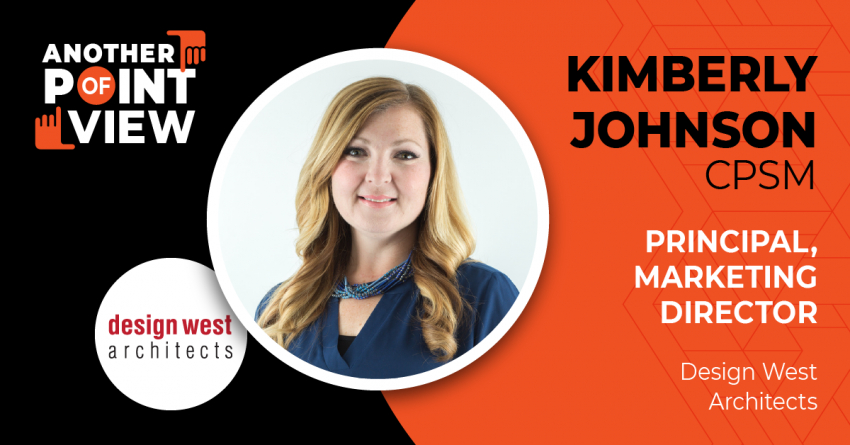Kimberly Johnson, Principal and Marketing Director for Design West Architects
As Marketing Director, Kim helps the firm win work. It’s a cyclical process, but it typically begins by making positive impressions and forming relationships with potential and current clients. With a relationship in place, we can be the “go to” professional when a client needs help with an architectural problem. When qualifications are requested, Kim leads the project pursuit to show why we are the best team for the job and coach our team for presentations.
“I’ve worked in the AEC industry for 17 years and I couldn’t imagine myself in another field. I love seeing projects I’ve helped the firm win come to life. I especially enjoy forming connections with others in the industry and using my network to benefit friends and my firm.”
Kim is living her lifelong dream of horse ownership. She has two horses right in her backyard. Her husband and two daughters are “along for the ride” and very supportive. They love taking care of the horses as a family.
As a firm leader, what have you done to educate your technical staff about the importance of their involvement in marketing/business development? How have you provided another point of view?
- We provide training for our technical staff that is related to marketing and business development. Many of our technical staff members are new to the idea of business development in general, so we connect them to the idea that everyone is responsible for bringing in work and clients, retaining clients, and building our brand. Sometimes, because we are a smaller firm in this market, we get people who have been in larger firms and may not have had the responsibility given to them. It is very helpful to educate them on the expectations and the opportunity to build that skill set. In some other firms, they don’t get those opportunities and don't get to build those relationships. We have had great success with all levels of technical staff members, from our Revit managers to management, being receptive to being onboarded that way.
- We try to have a business development “Lunch and Learn” at least quarterly. We have two offices, and we do this training with them in-house. We ask everyone to attend, provide lunch, and make it a social and learning experience. I prepare our more experienced staff members to participate and give advice and a mentoring opportunity where they can be part of the presentation. I want them to actively interject and give examples of how past business development activities have gone well and lessons they have learned. Sometimes, business development can seem like an abstract idea when you don’t do it very regularly. This training just gives them that level of exposure is very helpful with their self-confidence. They get a better understanding of their part in client relationships and the importance of their interactions with our clients. Our philosophy of business development is to utilize the “Zipper Approach.” This is a philosophy where we match newer folks with their counterparts within our client’s organization at their level, and they can develop their relationships and grow together in their career. Another benefit of this training is that the more seasoned business developers can tell stories of how they have grown their network. A person who is your competition today could be your client tomorrow. It's a small industry, and we need to lift each other. We feel that we are educating everyone in the firm, whether you are a receptionist, principal, intern, Revit manager, etc., everyone catches the vision.
- Another way we provide training and resources for business development is to enable those on the front lines to have autonomy to do what they feel is best with their clients. We give them a monthly business development budget that doesn’t require approval from me, a principal, or accounting. They know how best to interact with their network, and if they are within their budget for the month, they are empowered to use that to build those business development networking connections. Some take good advantage of it and others need reminding, but in general, people appreciate that freedom and use it the way they want to. Sometimes it’s used for going to lunch, coffee, golfing, skiing, or whatever it is they enjoy doing with the client.
- We also provide opportunities for professional development and for them to be out in the industry making connections. We have a budget for both marketing and business development and then a separate budget for professional development. This enables them to make connections with their assigned market segment by serving with professional organizations where the clients are networking. It is very important to building those connections.
Is there someone who mentored you that made you view marketing and business development with a new perspective?
- The first person who comes to mind is Mike Buell. He taught me to really think from the client’s perspective. I would have thought that after 10 years in the industry, I would have already figured that out. I knew it, but he made me truly think about the "why" and introduced me the "so what?" concept.
- He made me understand what thinking from the client’s point of view would mean to them. Our clients put in some much time and effort to make their projects come to life. They typically aren’t technical professionals, so they are giving all their energy to meet a need they have. For example, for an agency that needs state funding for a project, someone had to have a vision or a need, they have to sell it to those that can give approval to try and get funding and make it a priority for several years, convince the state to choose them to get the funding, and then champion the project through the bureaucracy to make it a reality. Mike emphasized that “we”, the architect, needed to speak to them understanding everything they have gone through to get the project to happen and really understand their needs. Our team was talented with design and helping clients achieve their vision, but we took those initial steps for granted.
- Mike's explanation of thinking through all those steps was very helpful. He specializes in introducing those key points in cover letters. He taught me to talk about those points and why this project is so important to the client in the cover letter instead of why we were qualified. He helped us shift our focus to talk about the client and why the project was important to them and how it would help them. That was a paradigm shift for our cover letter and the whole proposal process. It’s something that I use daily in our cover letters and also throughout the proposal.
How do you get firm leaders on board for your marketing initiatives?
- I learned from Cynthia ReMine that we need to plant seeds of ideas. The ideas we generate are often brilliant, but as marketers in a conservative industry like architecture, we often face resistance to change. To stay competitive, we need to be constantly evolving. The important thing is that the change happens, not who came up with the idea. We need to push the envelope forward, even if it's an incremental adjustment, so we eventually reach our ultimate goal.
- Our strength lies in strategy and vision. We need to get leadership aligned with the same vision of where we're going and then direct them towards that goal. My strategy is to talk about it in different ways, motivate, and give bits of inspiration and ideas in small amounts. Even if the idea doesn't come from me, when I can support someone else's idea, we can work together to push for change. When two people are pushing for something, it gets done. If it's just me, it can feel too aggressive. But if we slowly educate and implement ideas, we can reach our destination of success.
What are three tips you give marketing coordinators to help them progress in and magnify their role?
- My first suggestion for marketing coordinators is to prioritize your membership in SMPS. If your firm does not currently pay for it, figure out the value proposition for your firm and sell it or pay for it yourself. It’s just that valuable. I prioritize SMPS for not only my essential marketing coordinators and my marketing intern as well. It is what catapulted my career once I was able to join SMPS. I credit SMPS for the expansion of my awareness of what AEC marketing is. The connections that have made my career.
- The next thing I would tell them is that “you have value.” Within your firm, typically you could be one of a very few specialty employees within your firm. That is valuable. Even though you may not be part of the technical team, your perspective is the client’s perspective. They are not technical either. Your training as a professional marketer is valuable. So, when you can recognize that value and then bring it to your team, that is when your team will also recognize that value. That means be active in showing that value. That means when you are putting together strategy, qualifications, you are actively trying to improve the information your firm has available. Our job is to sell yourself.
- Finally, take charge of learning the technical side of the industry so you can be a resource to the technical staff. Our job is to elevate the information from our team members and look at it from the client’s perspective and ultimately sell your firm. You are not going get that level of writing from technical staff. That is your job. Don’t rely on them to write that content for you. Being able to understand the projects your team members are working on is very important. You have to learn to write and learn how to interview them to dig in and understand the technical side and translate to marketing verbiage. That is the different between an essential employee and someone who is not essential. They are going to keep that person and will see that value every single time.






